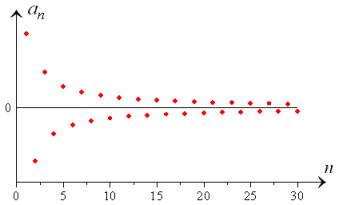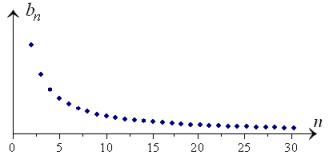|
A numerical sequence
is a set of ordered values of a function, whose domain consists
of the set of all natural numbers in ascending order of the numbers.
|
The elements of a sequence are called the terms.
The n-th term of a sequence is called the general term or variable of the sequence. The general term is denoted by a lower case letter with the subscript n:
![]() ,
, ![]() ,
, ![]() ,
, ![]() ,
, ![]() ,
, ![]() , etc.
, etc.
Usually, index n takes on values 1, 2, 3, ...
A numerical sequence is completely determined by its general term. To denote a sequence, we use the general term in braces:
![]() ,
, ![]() ,
, ![]() , etc.
, etc.
| Graphic Presentation of Sequences |
By the Number Line:


By Two-Dimensional Chart:


Examples of Sequences:
The elements of an arithmetical progression
![]()
are the terms of a numerical sequence with the general term ![]() :
:
![]()
The general term ![]() determines the sequence
determines the sequence
![]()
The sequence
![]()
has the general term
 .
.
| Bounded and Unbounded Sequences |
|
A sequence for each natural number n. |
Any nonempty upper-bounded sequence has the least upper bound.
|
A sequence for each natural number n. |
Each nonempty lower-bounded sequence has the greatest lower bound.
A bounded sequence has an upper bound and a lower bound at the same time. Otherwise, a sequence is unbounded.
| Monotone Sequences |
|
A sequence for each natural number n. |
|
A sequence for each natural number n. |
